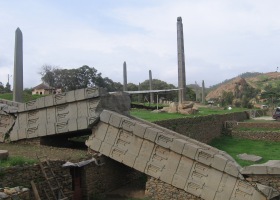
AXUM (2100m altitude)
Located in northern Ethiopia, Aksum reached its height between the 1st and
10th centuries, recalled in later centuries as a golden age. This was a kingdom
of great wealth and sophistication, controlling the caravan routes from the hinterland
of Africa, and the ancient Greek geographers describe its trade in ivory and slaves.
Its kings minted a gold coinage when almost no one else in the world was rich
enough to afford it or sophisticated enough to require it.
Aksum's
mythical past has been preserved in the famous epic known as The Glory of
Kings. This describes the Queen of Sheba traveling from Ethiopia to visit
King Solomon in Jerusalem, in the hope of learning something of his famous wisdom.
The king is fascinated by her beauty and her intelligence, and the son who is
born from their union becomes the founder of the Ethiopian dynasty. When he travels
to Jerusalem himself to be anointed by his father, the Ark of the Covenant, the
chest containing the tablets of stone inscribed with the Ten Commandments, accompanies
him to Ethiopia, where it will remain until the End of Time and the Last Judgment.
According to Ethiopian tradition, the Ark of the Covenant
Akum because
of its antiquity and close contacts with both east and west was involved at one
time or another with no fewer than four of the world’s religions, the Hellenistic
faith of the ancient Greeks, whose Gods are honored in the Earliest Akumite inscriptions
as well as three great monotheistic faiths, Judaism, Christianity and Islam. Each
of these faiths, and in particular the later two, have played its own formative
role in building the culture and society of Ethiopian today.
The
Aksumite kingdom conversion to Christianity makes Ethiopia one of the oldest Christian
countries. Christianity, which became the official creed of the Axumite state
early in 333 AD, during the rain of king Ezana, Ethiopia, became the land of innumerable
churches and monasteries. The oldest of these churches and in deed the oldest
church in Africa south of Sahara is the original St. Mary of Zion, which dated
back to the forth century. It was burned down in 16th century (1535) by the Muslim
invader Ahmed Gragn. Years later it was subsequently replaced by battlemented
structure constructed by Emperor Fasilades in the Early 17th C, 1662 in the same
style as his castle at Gondar. A third church of St. Mary and the only one open
to woman was built nearby in the mid 1960’s by Emperior Haileselasse.
Aksum is the holiest city in Ethiopia. According to the Orthodox Church,
the original Ark of the Covenant, which holds the Ten Commandments, remains at
Aksum today, under close guard of a priest. The Ark is supposed to live somewhere
in the grounds of the 17th-century St Mary of Zion church, but of course no one
is allowed to look at it. The church's museum has a small but impressive collection
of bibles, crosses and crowns.
Just past the museum is Aksum's ancient
stele field, all that remains of the city's past glory. Stelae are huge, carved
pillars made from single blocks of granite. The largest obelisk, which was
35 meters long and weighed 500 tons, is the biggest piece of stone ever
cut by humanity anywhere in the world but today it lies broken on the ground.
Near it stands a smaller but nevertheless most impressive 24-metre-high obelisk
- the pride of Ethiopia. A somewhat larger obelisk was taken to Rome; on the
orders of the Italian fascist dictator Benito Mussolini, in 1937.This has
returned back to is home, Akum recently. Plans are also under consideration for
the re-erection of the obelisk.
If you take a walk outside
the town, you can have a look at the ruins of King Kaleb's Tomb, and if you keep
going up the hill you'll end up at the Pentalewon Monastery - women aren't allowed
in, but the views from here are lovely. The ruins of the Queen of Sheba's Palace
are also outside the town, although archaeological investigation suggests they
are 1500 rather than 2500 years old.
YEHA
Yeha is situated 55 kms east of Axum, accessible
by the main road to Adwa, past the very dramatic scenery of the mountains of Adwa
- site of Emperor Menelik II's famous defeat of the Italians over a century ago-then
by a small road turning right wards Enticcio. This whole area shows an almost
incredible amount of terracing-noted already in the last century but of unknown
original date- on the flanking hills. From the secondary rode one turns left on
to a track for 5 kms to rich to the splendid valley, in which, on a knoll backed
by the surrounding hills, stands the temple. The imposing structure is visible
from the distance, raising above the church of Enda Aba Afse and its enclosure.
The temple is a magnificent structure, which has no equal anywhere in Ethiopia.
Extremely well preserved, with up to 52 course masonry, it dominates the whole
valley with its high windowless wool. It was Ethiopians first known capital in
the 5th century BC. Yeha is considered as the birth of the countries earliest
civilization. The pre Christian massive walls of the Temple, ruins at the old
capital and inscriptions dating from the 5th century BC and the nearby church
are worth to visit.
DEBRE DAMO-MONASTERY
The ancient monastery
of Debra Damo is the oldest standing church in Ethiopia and the center of the
Ethiopian church. Debra Damo is built on a high plateau north of Aksum, and can
only be reached by scaling a cliff by means of a leather rope. Its inaccessibility
gives some clue why the monastery served as a sanctuary for Ethiopia's rulers
during times of war.According to Ethiopian tradition, holy men known as the Nine
Saints arrived in Ethiopia in the 5th or 6th century to spread Christianity. One
of these men, Za-Mikael Aregawi, is believed to have founded Debra Damo. It was
a monk trained at Debra Damo who became the patron of the Solomonid pretender
Yekuno Amlak, and helped him to overthrow the last of the Zagwe kings. Especially
during the Zagwe dynasty, the aristocratic families of the north saw the great
monasteries as an alternate base for power. As the wealth of the monasteries depended
on temporary land grants known as gült, the abbots had to possess
the sophistication of a courtier. The king often used these grants to enrich the
monasteries that would support him, and the Zagwe were quite rightly suspicious
of Debra Damo.
Check Related Trips:
Trip
to Axum By air
Trip to Axum On
Land


